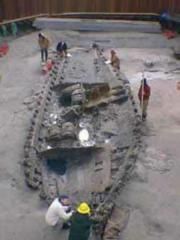Milam County Historical Commission
Milam County, Texas
Milam County, Texas






All articles from the Temple Daily Telegram are published with the permission of the
Temple Daily Telegram.
All credit for this article goes to
Jeanne Williams and the Temple Daily Telegram
Photo courtesy of
Texas Parks & Wildlife Department
Temple Daily Telegram.
All credit for this article goes to
Jeanne Williams and the Temple Daily Telegram
Photo courtesy of
Texas Parks & Wildlife Department
Speaker to dig up the past;
La Salle’s sunken ship to be topic
by Jeanne Williams
Temple Daily Telegram - October 6, 2008
ROCKDALE - The story of the excavation of shipwrecked 17th century French ship Belle
is as fascinating as the account of explorer Rene-Robert de La Salle’s journey to the
New World, and will be presented by archaeologist/author Dr. Jim Bruseth at a Milam
County Historical Commission program Tuesday, Oct. 14, said organizer Dr. Dee Dee
Green.
In observance of Texas Archeology Month in October, the county historical commission
is inviting the public to a two-hour program starting at 6 p.m. in the First Baptist
Church, 240 Green St. in Rockdale, featuring Bruseth, Texas Historical Commission
archaeology division director.
Bruseth and his wife, Toni Turner, wrote a book titled “From a Watery Grave,” based on
the excavation of the Belle, Dr. Green said.
Autographed copies of Bruseth’s book will be available at the event, Dr. Green said.
Bruseth will chronicle the excavation of the ship and the story of French explorer La
Salle, who embarked from La Rochelle, France, to establish a colony in the New World.
In February 1686, the last of his vessels sank in a violent storm in Matagorda Bay.
Thirty miles inland near the present-day city of Victoria, La Salle established Fort
St. Louis as a settlement for pioneers who accompanied him to the New World. None
survived, including the famed explorer, the Texas Historical Commission reported.
Nearly 300 years later, Texas Historical Commission archaeologists discovered the
wreck of the Belle, and with it an entire “tool kit” for survival in the New World.
“I worked seven day weeks and 12-hour days, but had one of the most fascinating
archaeological jobs in the world,” Bruseth said. “Our decision to excavate the entire
shipwreck at once yielded invaluable information that would have been difficult to
discern from a series of field seasons.”
A giant cofferdam - built around the vessel to pump seawater out so archaeologists
could work in a dry environment - earned the attention of nautical experts from around
the world.
Severe storms threatened the safety of staff keeping watch over the work site at
night. The state of Texas, as well as public and private resources, assisted with
funding the massive project, which resulted in the excavation of more than 1 million
artifacts, including a crewmember’s skeleton and the ship’s hull.
The Belle is one of the most important shipwrecks ever discovered in North America.
The excavation in 1996-97 led by Bruseth lasted almost a year and produced an array of
finds including three bronze cannons, thousands of glass beads, bronze hawk bells and
pottery. The 1 million artifacts represent items needed by an explorer to colonize the
New World, but today are considered priceless historical treasures, Dr. Green said.
The project has now shifted to the conservation phase, in which every artifact is
carefully identified, cleaned and preserved. The hull of the ship has also been
reconstructed and is undergoing chemical treatment to preserve it. Artifacts that have
not been treated, numbering in the tens of thousands will decay over time and their
historical significance will be lost, Dr. Green said.
Many Belle artifacts are currently displayed at the Bob Bullock Texas State History
Museum in Austin, and others will be exhibited in museums around Matagorda Bay.
The Texas Historical Commission excavated two of Texas’ most important archaeological
sites relating to La Salle. First was La Salle’s ill-fated ship, the Belle, and the
second occurred in 1999 to 2000 when archaeologists explored Fort St. Louis, the
settlement La Salle and his stranded colonists established on Garcitas Creek.
After the excavations, seven museums in six Texas coastal counties banded together to
create the La Salle Odyssey, a series of exhibits that together tell the extraordinary
story of La Salle’s expedition and the THC excavations.
Each October, the historical commission observes Texas Archeology Month to promote
this spirit of discovery, and provide the opportunity for Texans to understand the
depth and richness of their heritage from the former dwellings of prehistoric hunters
to ancient shipwrecks and Civil War sites.
Texas Archeology Month began Wednesday. This year’s celebration across the state
includes demonstrations of native crafts and technologies, lectures on archaeological
topics, exhibits on archaeological sites or topics, tours of historical sites,
laboratories or exhibits, and hands-on activities, such as mock digs and rock art
replication, the historical commission reported.
A crew excavates La Salle’s sunken ship, the Belle, in Matagorda Bay. The excavation in 1996 led by Dr. Jim Bruseth lasted almost a year and produced an array of finds including three bronze cannons, thousands of glass beads, bronze hawk bells and pottery. On Tuesday, Oct. 14, Bruseth will give a presentation on this historic excavation at 6 p.m. in the First Baptist Church, 240 Green St. in Rockdale. (Photos courtesy of Texas Parks and Wildlife Department)

.